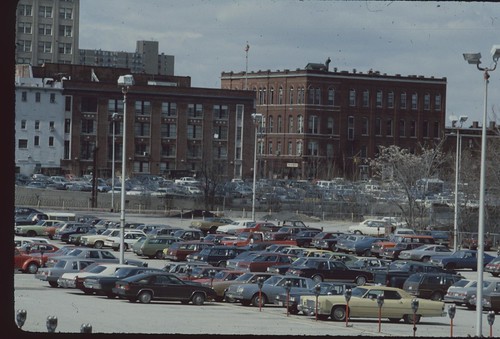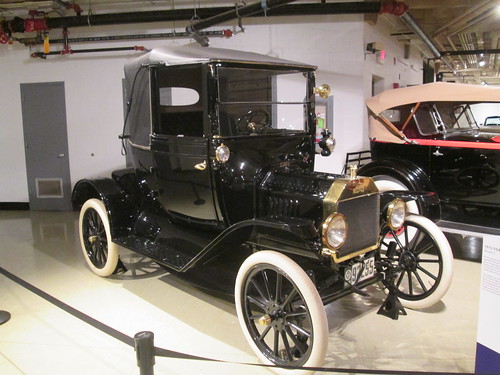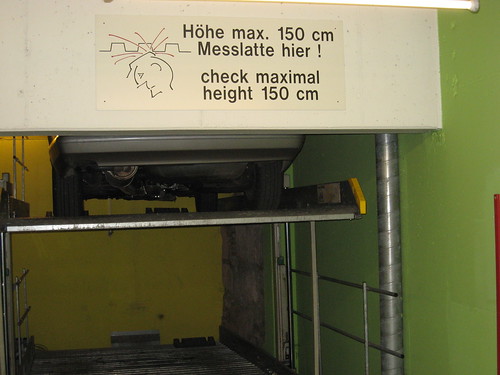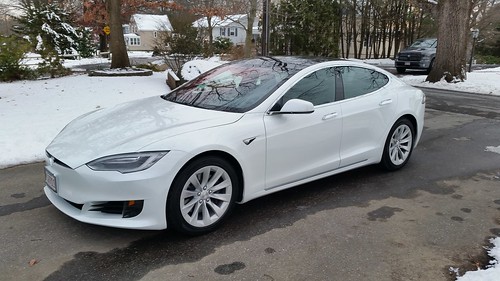Lowell Week in Review: December 17, 2017

Davidson St and Rex parking lots, looking towards Kearney Square
Discussion of two proposed modifications to the city’s zoning code dominated last Tuesday’s Lowell City Council meeting. Both involved parking and both were rejected by councilors. The first would have eliminated the parking requirement for a microbusiness, meaning a business in a small space with few employees. This amendment was intended to help with the creation of small businesses in downtown and other congested areas where parking spaces are either very expensive to construct or not available at all. Councilors opted for parking availability over business creation and rejected this amendment.
The other failed amendment would have changed the way that the distance from a dormitory building to a public parking garage would be measured. The existing code requires the two structures to be within 1500 feet of each other but specifies that the distance be measured as a car would drive it. The sole purpose of the proposed amendment was to change the method of measuring that distance to a straight line as determined by GIS technology. Councilors rejected this proposal not because they are hostile to straight line measurement; but because they are hostile to the underlying provision – the 1500 feet from living quarters to parking – that has been in the city’s zoning code since 2004. The basis of the hostility to this distance allowance was that dormitory residents would park their cars on nearby neighborhood streets rather than at distant parking garages.
Setting aside the fact that most college dormitory residents do not have cars and that it is commuter students who are parking on neighborhood streets, this debate demonstrated once again the preeminence of parking in Lowell city government’s concept of urban planning. In some ways, this elevation of parking above all else is a proxy battle in the never-ending struggle over Lowell’s identity – are we a city or are we a suburb? Because if we’re a city, every trend in urban planning in America is towards loosening parking requirements.
This urban trend of reducing parking requirements is not just a matter of promoting bike lanes, walkability or public transportation, although those are all a big part of it. The major driver of this trend is that technology is even now changing the car culture that we’ve known for more than a half century.
My latest research project is studying daily life in Lowell a hundred years ago. The result will be Lowell in World War One, a book out next fall, co-authored by Eileen Loucraft who writes the Lowell Doughboys blog, and published by Paul Marion’s Loom Press.

1915 Ford Model T
Besides everything else that was going on (i.e., a world war), the years from 1914 to 1918 were a time of enormous technological change in Lowell. Street cars were a constant and served the transportation needs of most people, but in 1914, most traffic accidents and street congestion involved horse-drawn wagons and carts. By 1918, the automobile had replaced the horse. Predictably, society struggled with how to use and regulate this new technology. Were police officers supposed to enforce the speed limit, or was it someone else’s responsibility? Should “jitneys” (that era’s Uber and Lyft) be licensed and if so, by whom?
I think about this century-old technological transition every time I read an article about self-driving cars, because I believe we are at a similar tipping point today with the coming of autonomous cars. Given some of the drivers I encounter on the road – especially those stealing a long glance at their cell phone as they veer into my lane – I can’t wait for computers to take the wheel. Self-driving cars will radically change the way we get around, but they will also revolutionize the way we park.


German parking lot (2007) maximum number of cars in minimum amount of space
A self-driving car will need much less room to park. The driver will have gotten out long before the vehicle pulls into a space, so there will be no need to open doors. That means cars will be able to park as close as four inches apart, greatly reducing the overall space needed for parking. Similar changes on an even bigger scale will take place with where parking is located.

2016 Tesla – a software upgrade away from fully autonomous driving
Are self-driving cars inevitable? I think they are. I recently replaced my six year old vehicle with a 2018 Kia Optima, a wonderful car at a great price, but hardly a Tesla. Still, with all of its sensors, cameras and automated systems, the next leap to fully autonomous is easy to imagine.
Consider a new downtown residential apartment or condominium in the planning stages today. If your autonomous car can drop you at the front door of your apartment complex then drive a half mile to a parking garage and park itself, why should we require onsite parking and thereby increase the cost of the development to the point of fiscal unfeasibility? Self-parking cars may not be with us today, but they absolutely will be in our midst ten years from now, more likely five. As we have seen from the Hamilton Canal experience, major developments can take a decade or more to come to fruition. Shouldn’t we at least be discussing what the rules should be ten years from now rather than reflexively limiting ourselves to life as we have lived it for the past fifty years?
I’m not advocating that we tear up our zoning code as it relates to parking requirements. What I am saying is that we are today making decisions about new parking garages that cost $35,000 per space without even considering the coming implications of autonomous cars. Should we be committing ourselves to 20 year bonds for expensive new parking garages when autonomous vehicle technology could make those garages obsolete in half that time? That doesn’t make a lot of sense.
In addition to these easily imaginable changes that autonomous cars will bring to parking, some believe that self-driving cars will make the entire concept of parking obsolete. Unless you’re a visiting nurse or a UPS driver, how much time do you spend driving your car? Most estimates say the average car is vacant 95 percent of the time. That’s a fair estimate for my vehicle.
Those who theorize about self-driving cars imagine a super fleet of shared autonomous vehicles which will pick you up where you want, when you want, and deposit you at the door of your destination with no effort on your part – and with no need to worry about where you are going to park. I don’t believe that such a service will eliminate privately owned motor vehicles entirely, but it very well could allow families that now have two or more cars to reduce that number to one.
Reducing the number of cars in use each day, and using those in operation more efficiently, are the keys to reducing traffic here in Lowell. We’re not going to solve traffic congestion at the Rourke Bridge by widening the Rourke Bridge. Experience tells us that widening roads and bridges just brings more traffic to the roads and bridges. Instead of having two lanes of bumper to bumper traffic, we’ll have four.
From time to time in this space I’ve been critical of the city council for a lack of strategic planning. This issue – the coming impact of autonomous cars on parking and traffic in Lowell – is an example. Within a decade, autonomous cars will radically change how we use our roads and our need for parking. In terms of urban planning, a decade is a blink of an eye, yet no councilor has raised this issue, much less initiated a meaningful discussion about it.
Maybe the incoming city council will form a subcommittee that studies how new technology will change Lowell. The future is not here yet, but it is coming rapidly. Our planning should reflect that, not ignore it.
Besides using its own planning staff, the city council should enlist UMass Lowell to help the city prepare for the future. Back in March, I attended an event at the UMass Lowell Inn and Conference Center. It was the annual Distinguished University Professor lecture which was delivered by Professor Robert Forrant. In his remarks, Bob covered a number of topics, but the one that stood out for me was his advocacy for an Innovation Hub for the Humanities, Fine Arts and Social Sciences. He described this innovation hub as “a place where faculty and students from those disciplines could come together, collaborate, interact with the public, and attack the ‘big problems’ of society such as access to education, job creation, income inequality, and many others.”
Parking and traffic congestion might not raise to the level of education, job creation and income inequality, but they have a profoundly negative effect on our economy and the quality of our lives. The more we can embrace new technology and coordinate our planning in ways that are consistent with that new technology, the better off we will be.
Lowell was the Silicon Valley of nineteenth century America. Innovation is part of the city’s DNA. We should be leading the way in understanding how this coming wave of new technology can be used to solve our problems, not ignoring it.
Insightful article today. I think autonomous cars will also see an expansion in home delivery services. Several localities are using robots for delivery. Pairing them with a autonomous vehicle. Will allow smaller businesses and/or perishable products to be delivered. No danger of robbery. Allow narrower delivery windows etc
Dick, great read as always. I went to Mill #5 yesterday for my first time ever. No practical parking. Still, was able to figure it out, find a spot, and go in. Place was PACKED with people. They must have all figured it out too. If there is a good product, motivated people will find a way to support it and get there regardless of the parking situation. Eliminating some minimums is a great idea.
It would be nice to know who stood where on these two votes.
Self driving cars are a piece of the parking puzzle but won’t likely solve our congestion problem – the other villain of car dominance.
Won’t empty cars circle downtown waiting for it’s next booking? Will people consider living further away where housing is cheaper if they can sleep or work while being driven around? And how frustrating will it be when autonomous vehicles actually follow the speed limit and fully stop at stop signs etc. Type A personalities won’t put up with AV’s.
From what I’ve read AV’s are better suited for highway driving and could be a nuisance in cities.
That said we need a complete overhaul of our parking policy. Hartford CT eliminated minimum parking requirements downtown a couple years ago. It’s been so successful they rolled it out citywide last week.
https://usa.streetsblog.org/2017/12/13/hartford-eliminates-parking-minimums-citywide/
Tick tock tick tock. That’s the sound of Loui Loui, in Kearney Square, going out of business since it’s located on a soul crushing stretch from Prescott St to the Bridge St bridge, its main function being car throughput.
It’s disgraceful what’s happened to our most famous square in the name of car culture. Metered parking should be allowed in that whole area. Would be great for auditorium visitors, Kerouac park self-policing, and businesses.
Maybe a parking board would be better than a subcommittee. It’s become too political to make changes. Could potentially save the city millions.
The argument that making the Rourke Bridge four lanes will just bring more traffic (like the letter to the Boston Globe a while back opposing fixing the I-93/I-95 interchange because it will cause more folks to drive) forgets that some of those new cars on the bridge are coming from somewhere else, lessening the load there as people continue to explore for the best route. Where is the traffic snarl being reduced? And, it seems to assume that the freedom to use one’s vehicle to conduct business or pleasure is an evil that needs to be stamped out. I find that to be a discouraging state of mind.
And, there is always the Marie Sweeney Bridge option, from I-495, over Tewksbury and the Merrimack into Dracut (first interchange) and then up into New Hampshire). Let Dracut no longer be land locked. And do it before we destroy the Lord Overpass.
Regards — Cliff
C R,
Induced Demand supports the argument that congestion will be just as bad with a wider Rourke bridge. When the chief constraint against driving is congestion and you make it easier to drive you get more congestion.
Many folks who choose not to drive over the bridges at peak times wouldn’t have that constraint anymore and latent trips would be realized. Congestion is like a gas that expands to fill up the available space until the pressure equalizes.
It would also send a strong signal to developers to build more car centric sprawl in Pawtucketville, Dracut, and Tyngsboro.
It’s not that driving is evil, even though 37k die by car every year in US, but that it manifests the most wasteful development pattern the world has ever known. Lowell is lucky enough to have a traditional development pattern in and around downtown that can be repaired to improve our fiscal health – property taxes being so important to our well being.
Advocating for protected bike lanes and better walkability for me is about supporting infrastructure and a land use pattern that has a higher ROI than sprawl. It’s more resilient to macro economic forces that threaten our outside funding. I’m definitely not for banning cars but for reducing their dominance in our city.
I don’t believe the point is to stamp out vehicle traffic but rather curb it’s dominance. The Data is undeniable – Cars are like water, they will fill all space available to them. Adding lanes = additional cars. The fact that some of those vehicles will come from other roadways is inconsequential; your still encouraging more vehicular use.
The question is – Why, at this point, would we want to further feed into an already dominant car culture when we know that the alternatives are healthier & more sustainable.
& connecting Dracut to 495 is an idea straight out of 1965. Total insanity.
Brian and Jason,
Thank you very much for your thoughts here. I happen to agree with them although I believe that there are some points you make that should be uncovered a bit. You suggest that with a new four lane bridge over the Merrimack that there will be increased development and therefor more concomitant auto traffic. I would say that this auto traffic would not just be commuter traffic, but would include people getting to and from services that would then be more remotely located from more far flung residences. Eventually, services would move to these locations and become more centralized to these growing communities.
This all strikes me as quite antithetical to good conservative thinking (the American Conservative site offers some nice pro-urban conservative perspectives: http://www.theamericanconservative.com/web-categories/new-urbanism/). We, as a society, will be spending money and energy on building new roads, housing, and services, e.g. schools, utilities, shops, etc. Whereas we can invest in maintaining our current infrastructure in such a way that we promote public transit, bike and pedestrian oriented living.
By using money and resources to build new roads and bridges that promote expansive sprawl inducing development we perpetuate the model that the Lowell Mill owners followed when, instead of investing in the maintenance and upkeep of their mill buildings. As I understand it they invested their capital in new buildings in the south, while neglecting the structures here in Lowell. This forced them in the end to have higher labor costs here since they needed to pay for materials and labor to fix their deteriorating buildings. This made the cost of labor here higher than in the south.
This all seems quite antithetical to conservative ideals. For our society cannot now afford all of our infrastructure. Many communities cannot afford to maintain their roads and other infrastructure. I am not opposed to any expansion of roads or bridges, or other transit projects for that matter, but we should make sure that we promote projects, laws, ordinances, and developments that make it easier for people not to drive as much. This,if properly done, will go far in reducing auto congestion, traffic fatalities and pollution. Such living situations should in turn benefit our health and be cheaper and more efficient to maintain. When more people can walk to services, there will be more social interaction, thus promoting local communities. This all seems more conservative than promoting sprawl and the isolation from the frequent and driving required from such auto-centered development.
I apologize for my diatribe here, but I honestly think we need to examine what is conservatism.
I feel I should explain myself here. My father, as I see it, was more conservative than most Republicans. He was born in Syracuse, NY just before the Great Depression. He was a chemist working in the paper industry and fell in love with New England. He later worked for the EPA in Chicago inspecting water pollution regulations and then later air quality at steel mills. We never through away cans, paper or other re-usable or recyclable items or left a light on without being scolded by him. Products, packaging materials were researched, contemplated and inspected before buying.
In the community he was a precinct captain and always involved in local affairs, not so much in nonprofit organizations that were in the news but would help out such organizations or anyone in need. He understood the importance of conserving resources, including, places, things and people.
He was the only one of nine siblings that abandoned the party of Lincoln, although the only living member of his generation now seems ashamed of his party. He loved New England mill towns and he understood the sense of place and belonging they provide. This sense of community is not conserved but becomes lost in sprawl.
Paul,
The beauty of urbanism is that it’s bipartisan and that it can be scaled to small towns like Peterborough Nh, mid-sized cities like Lowell, and major cities like Boston.
The advantage Lowell has over most places is the building blocks for good urbanism are already in place within a small geographic area so that our costs to reunite the neighborhoods to downtown with safe bike and pedestrian infrastructure are less than what big cities have to pay with light and heavy rail systems.
Allowing and encouraging more of our daily needs to be met in the neighborhood business districts is also a great way reduce car trips and manufacture opportunity for it’s residents. Requiring minimum parking requirements for micro-businesses is at odds with this.
When you’ve always known privilege, equality seems like oppression.
Big, expensive road projects come at the expense of dozens or hundreds of little projects, from new sidewalks to maintenance of existing local roads, that would advance important public values. Automobile mobility is not some God-given mandate that needs to take priority.